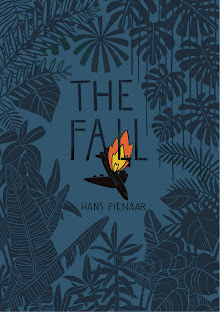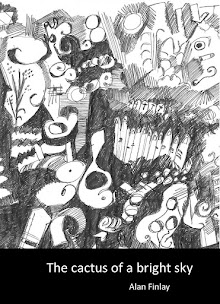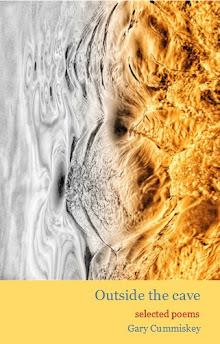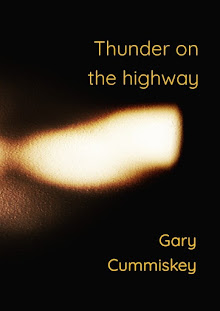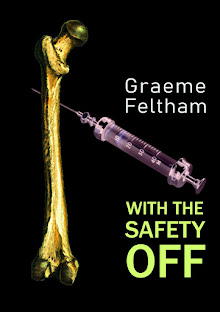A photomontage by British artist Paul Warren, inspired by the title of my poetry collection Sky Dreaming, published by Graffiti Kolkata in 2012.
Independent literary publishing, commentary, reviews, art
A photomontage by British artist Paul Warren, inspired by the title of my poetry collection Sky Dreaming, published by Graffiti Kolkata in 2012.
 |
| From left: Arja Salafranca, Gary Cummiskey, Shorty the Melville Poet, Karen Lazar. |
 |
| Arja Salafranca |
 |
| Shorty the Melville Poet |
Poetry evening at Spilt Milk, Melville, 21 February, 2023. Dark, romantic setting courtesy of Eskom.
Arja Salafranca’s two-page “Introduction” to her collection
of short stories, The edge of things, extols the virtues of the short story
genre and delights in the energy recently injected into the publishing of this
art. Written in the form of an editorial, this opening naturally also takes the
reader on a rather hurried tour of the many related themes contained in the
stories. My review, by contrast, focuses on a cumulative impression that the
stories make in relation to their challenging South African settings.
Her book is a helix of twenty-four short stories that
elaborate on what it means to expand moral compass in the South Africa that is
mired in prejudice and coercive discourses. This is a theme that sets the book
apart from some of the South African collections of poetry and short stories
such as The heart in exile and Transitions. These respond to the dawn of
non-racial democracy by valorizing the quotidian. The short fiction in Salafranca’s
book “gathers” the concept of the everyday into a coil of localities, each
vibrant with “governmentality”. Reading them resembles setting a whorl in
motion and watching a swell and quell of portraits of power. Some, fashioned by
the dominant social narratives of apartheid such as race and nation, appear to
jostle for prominence with those hatched in liminal spaces between whiteness
and blackness, and between the semiotic and the symbolic. Feminist in shape,
these images appear in manifestations that reveal complexities within possibly
the very basis of the dawn of nonracial democracy: the existential “being for
the other”. As a result, some of these stories deploy narrative perspectives
that deftly cross over ontological boundaries with ease.
The first story, “Bounce” by Jayne Bauling, sets the tone.
It is a striking reminder of a famous story, Jack Cope’s “Power”. Central to
this story is a young boy who successfully implores his parents to take pity on
a bird that is apparently trapped in an Eskom electric power line. The
narrator’s documentation of this character’s pleading on the bird’s behalf
incidentally spells out his maturation in terms of liberal human ideals.
Integral to this growth appears to be a valorization and privileging of nature
above industrialization. Bauling’s “Bounce”, by contrast, is subtly neither
interested in certainties nor in the kind of fruition that is linear. This
story considers an elderly woman’s concern about the fate of a bird caught in
the mouth of a dog. The story poses further questions about the moralities of
sympathy and intervention that have possibly yet to be elaborated upon in
ecocritical perspectives. For, as a human being standing outside of and,
paradoxically, within the world of animals where the norm is “survival of the fittest”,
how much swathe of human ethics is to be worn or shed in “being for the animal
other”?
Arja Salafranca’s “The iron lung” further expands on the
concern with how the human imagination can gel with everyday life. As it were,
this story subtly substitutes the notion of a desperate bird with that of the
narrator’s indigent mother and father, afflicted by polio and cancer,
respectively. Also reminiscent of “Bounce”, the focus falls primarily on an
able-bodied subject, Rosemarie, especially on her alleged magnanimity towards
her parents. Throughout the story, the narrative crisscrosses from her to her
mother who is described as being “in an iron lung” for the “last thirty-seven
years” (19). Both “voices” unwittingly corroborate each other, revealing that
her empathy for her parents is severely undermined by her intense unhappiness
in having to nurse them. This displeasure is apparent when she regrets that her
taking care of her parents makes her forfeit her basic right to have
relationships such as in marriage or having a boyfriend.
However, if, as also demonstrated in Magdalena Karina’s “The
basket”, the ethics of expecting compassion are gendered and patronizing, then
there is a need to argue for feminisms that are mobile and tactical. The
storyline, for instance, introduces the challenges. Elizabeth’s husband,
Rainer, has just passed on after his car had collided with another driven by a
woman whose name is not disclosed. The latter, comatose (77), is confined in a
hospital. Prior to his death, he was opposed to Elizabeth seeking employment
(69) and appears not to have been ardent when it came to love-making. This
seems borne out in the narrative’s flashback to one incident in which Elizabeth
poignantly reflects that “it had been years since [her husband had] tried to
give her any particular pleasure” (67). When the story concludes, she delivers
a bouquet of flowers to the woman at the hospital. This gesture appears to be
paradoxical, because it signals her sympathy for her, but may also hint at the
attempt to repress anger, perhaps as the passed-out woman is directly
implicated in the car accident that claimed Rainer.
Ostensibly, by virtue of (indirectly) knowing the extent to
which apartheid utilized them in order to mount a gendered racial supremacy,
white women in the post-apartheid of this collection of stories endeavour to
make up for the humiliation suffered by black men. In the story, “Cordelia, age
26”, the eponymous heroine artist suffers from manic depression, because she
had learnt that clients did not like her graphic art, as they were interested
in the black-authored ones. Subsequently, she hits the bottle and is ultimately
jilted by her late 40s black boyfriend, Desmond, who is described as having
never imagined white women as forbidden fruits to be plucked. Through this
simple plot, the story may be interpreted as a post-colonial response to Frantz
Fanon’s (1967, 41–82) notorious eliding of the white woman in “The woman of
color and the white man” and in “The man of color and the white woman”. In the
midst of one of her heated arguments with Desmond, the reader hears her
“begging Desmond to be black”: “You don’t consider me a true African artist
just because I’m white”, “Happy to lick the white pussy – but too embarrassed
to introduce her to your black mama” (173). When this story concludes, Cordelia
is taught by her only surviving relative, her white grandmother, to appreciate
the endurance of and to emulate working-class black women. But one chore
surfaces prominently: slaughtering fowl humanely REVIEWS Downloaded by [Brought
to you by Unisa Library] at 04:13 22 August 2014 132 and ethically. Presumably,
the sensitivities involved in this task, as they also resonate in “Bounce”, may
be apparent in another white female protagonist, that of Hans Pienaar’s
“Telephoning the enemy”, who reflects on how, not being “officially” subscribed
with the African National Congress, apartheid tragically fails to conceive of
the possibility of a full-scale war.
Also worth mentioning in this category of short stories that
may be considered dramatic elaborations on the theme of “being for the other”
are Angelina Sithebe’s “Sepia” and Jeanne Aromnik’s “Losses and gains”. In the first,
the principal characters are a 45-yearold (184) black woman who is apparently
haunted by “amadlozi” and her “sixty-five” (187) year-old white husband who is
terminal with cancer. He reveals the glue that connects them together through
mythopoeia after being initially opposed to her consulting “i’Sangoma”: “When
we met your terror reflected mine like a mirror … . I believe we met through a
connective energy in the dimension of the terminally petrified” (195).
By contrast, it seems that Aromnik’s “Losses and gains” will
not countenance that cross-racial romance happens only under psychologically problematic
contexts as, perhaps, the white male is indisputably the symbol of white
colonial power. This is why central to this story is an explicit account of the
alleged epistemic violence that informs J.M. Coetzee’s portrayal of women in
Disgrace. In order to find this critique persuasive, however, the reader needs
to agree to be hailed into “being for black women”. The power of this ideology
is enunciated by the black heroine’s bewilderment by and annoyance at Coetzee’s
apparently condescending approach towards the black women that his hero takes
sexual advantage of.
It seems, therefore, that one may chart a leitmotif of
gradual and systematic disavowal of the institution of marriage especially
when, pertinent to it, it is the heterosexuality that these stories portray as
misogynistic or that leads to psychological predicaments. Perhaps the story
that cogently introduces this decadence is Gillian Schutte’s aptly-titled
“Doubt” wherein the heroine is implicitly perturbed that “marriage … resulted
in only knowing your intimate self through the reflection of one other person
[or husband]” (59). This is because, in addition to his philandering, she
poignantly discovers that the extra-marital affair that she begins out of
frustration and loneliness is a mere farce that makes her project “the
archetype” of a faithful husband (59) onto her boyfriend.
From this disillusionment with the heteronormative and
racist discourses, it appears that, as dramatized in Bernard Levinson’s
“Tokai”, difference is possible via a “radical wing of the feminist movement …
the lesbian wing” (Eric Njeng 2007: 22). The plot of this story resonates with
the reclamation of what Njeng (2007: 26) calls the “first impulse”, that is,
the “primary relation” that all human beings have with their mothers and, for
lesbians, with “motherhood” (2007: 27). Told mostly from the perspective of a
midwife after she had assisted a woman of possibly black/Khoi descent give
birth, the narrative presents a graphic account of how the former began a
“secret dialogue between [her] hand and the womb” (126) as it engaged “rhythmic
pulsations, discharging the afterbirth and passing the movement onto her till
she “entered the pendulum beat, hearing [her] body” (126). It is interesting to
note that this is a “dance” that excludes the child’s father who, through the
narrator’s perspective, is part and parcel of the social symbolic that
immediately disposes of the “afterbirth”. In possibly classic African ritual
terms, the father’s ostensible burying of the placenta in the soil spiritually
reconnects the child with the ancestors and pleads with them to intercede on
its behalf.
The title story, Jenna Mervis’s “The edge of things”,
Jennifer Lean’s “The end”, Beatrice Lamwaka’s “Trophy”, and Dan Wylie’s
“Solitude” also explore liminality by focusing on the productive degrees to
which those who are marginalized by the violence of the dominant social
hegemonies re-insert themselves via tactical choices and strategies. However,
these stories do not contain the intense drama of maturation that involves
sexuality, emotions and rationality in comparable ways as Levinson’s “Tokai”.
By contrast, Kaganof Aryan’s “Same difference”, the story that appears to
associate male homosexuality with the Bohemian, is a puzzling oddity that seems
to have been included in the collection merely for the sake of enunciating
difference in radical terms. The dialogues in this story attest to people who
have retreated from “Life” (112), who associate it with the femininity that
they describe as sexually violent and who also reflect on themselves using the
very rhetoric of the homophobic: “we’ve been fucked upside down and sideways by
Miss Life. Neither of us was smart enough to surrender. We just taking it up
the ass. Two assholes” (112).
Works cited
Cope, Jack. 1979. Power. In: G.E. de Villiers (ed.), Close
to the sun: stories from Southern Africa. Johannesburg: Macmillan South
Africa.
De Kock, Leon &
Ian Tromp (eds). 1996. The heart in exile: South African poetry in English,
1990–1995. London: Penguin Books.
Fanon, Frantz. [1952] 1967. Black skin white masks.
NY: Grove Press, Inc. MacKenzie, Craig (ed.), 1999.
Transitions: half a century of South African short
stories. Cape Town: Francolin.
Njeng, Sipyinyu Eric. 2007. Lesbian poetics and the poetry
of Audre Lorde. English academy review 24(1): 23–36.
***********************************************
Dye Hard Press: South African Short Fiction, selected by Arja Salafranca, was published by Dye Hard Press in 2011.
This review by Sope Maitufi was published in Scutiny 2: Issues in English Studies in Southern Africa, in October 2012.
Paul
Warren is an artist and illustrator with an interest in surrealism and abstract
art. He works in a variety of different mediums, including collage. Paul's work
has been published by Dumpster Fire Press, The Odd Magazine and Word
Vomit Zine. He has online galleries at Deviant Art and Instagram. He lives in Daventry, England.
You live in the town of Daventry, Northamptonshire, in England. What is the art scene like in England these days? What is the support for visual art? Is there a fair bit of regionalism?
I think the art scene in England is pretty staid these days. It only exist in most people’s lives when Banksy sprays something on a wall somewhere. All of the big exhibitions are London-based, with a corporate sponsor. From time to time something interesting will pop up in an independent gallery away from the capital. I usually find out about these after the event. National media focus only on the big exhibitions: Monet or Hockney, for example. Living here these things easily pass you by! So yes, I think there is some regionalism. Read more.
This is the silver anniversary issue of The Odd Magazine, based in Kolkata, India.
It features poetry by Emmanuel G G Yamba, Jay Passer, Jim Landwehr, Kathleen Hellen, Matthew Friday, Scott C Kaestner and Susan Kotler.
There is also short fiction by Jacob Rousseau, Jamie Brown, Kenneth Pobo, Louella Lester, Paul Beckman and Stephen Nelson.
Art contributions are from Belinda Subraman, Michael Noonan and Serge Luigetti.
And last but not least, an interview with British artist Paul Warren by Gary Cummiskey.
Check out Oddity 25 here!
 |
| Arja Salafranca |
 |
| Medzani Musandiwa |
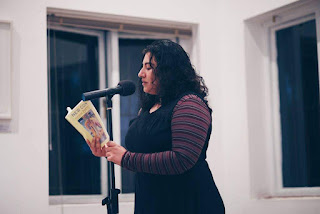 |
| Saaleha Idress Bamjee |
 |
| Raphael D'Abdon |
 |
| Linda Lindrish Ndlovu |
 |
| Dashen Naicker |
 |
| Lionel Murcott |
 |
| Gerard Rudolf |
 |
| Myesha Jenkins |
 |
| Kwenzakile Ntlati |
A man arrives in South Africa in 1994. He is from the Philippines, an archipelago of islands with a history of colonial oppression and the object of a tug-of-war between Spain and the US a hundred years ago. And having shaken of the colonial yoke, the islands then became subjected to a series of dictatorships and rampant corruption. It’s something that sounds somewhat familiar.
This is no doubt why Jim Pascual Agustin’s latest poetry
collection – his first to be published in South Africa – resonates within the
contemporary South African context, since both the subjects and imagery remind
us of our own history and more recent tribulations.
The first poems in this collection, such as ‘After the First
Monsoon Rain’, ‘The Crabs’ and ‘Naartjie’ deal with childhood, but even within
this cocoon of innocence the outside world of pain, fear and violence
occasionally intrudes, such as in ‘You Had to Leave’, which starts: ‘Nightmares
no longer scare you / like they used to’, or more strikingly in ‘Seeing in the
Dark’, in which the child is given the following prophecy:
you will
leave your country
stare
loneliness in the eye
bury the
dead among the living …
Indeed, it is only a few poems later that violence and oppression burst into the poet’s consciousness, and the past world of innocence is crushed like his family’s house in ‘Dragonflies’:
The government
didn’t just tear down
its
foundations. They buried it
under twenty
feet of soil.
And in ‘Face in the Tar’ the children of the dictator are showered with lavish gifts while ordinary citizens go without, and anyone who dares speak out will ‘disappear from their homes and be found / floating down a river …’ But life still continues under such conditions, and the poet even undergoes military conscription, wearing:
Hand-me-down boots
deep jungle green
a size too big, reeking of
memories
of someone else’s feet.
Not surprisingly, there is also the rousing voice of resistance, as in ‘Defiance’ or ‘We Will Not Allow The Dead To Be Silenced’:
unclaimed in morgues
or dumped on the side of the road,
their faces bound with packaged
tape,
they will never be silenced …
But Agustin does not focus solely on contrasting worlds of innocence and (political) experience ‒ to do might risk becoming formulaic, predictable and one dimensional. In the second part of the collection there are poems more intimate in tone, with memories of his father, such as ‘Rats’ and ‘My Father, Leaving’ , or meditations on aging and mortality, such as ‘Angels of the Old Cemetery’ or the somewhat alarming ‘What I’ve Always Been’:
someone who loses and gains
all the time. Not seeming to care
or able to see an oncoming train
on its side, the ground grating
against its metal skin, screams
twisting on the tracks …
The collection consists of both new and selected poems – some written in English and others translated from the Filipino ‒ though with the exception of some giveaway poems, such as ‘Sunday, Rondebosch’ and ‘The Undiminished’, it is not clear which are older poems, perhaps written before his arrival in South Africa, and those written since living here. ‘The Undiminished’, for example, opens with a description of a clearly recognisable South African suburban peak-hour rush to work:
….
a dash to join
others who wait in line
for a taxi packed beyond capacity.
Always, the unavoidable
pressing of skin against skin,
sharing
the scent of familiar strangers.
An eternity to get to work …
Considering Bloodred Dragonflies is a selected volume, it is a pity there is not a greater number of poems – I certainly wanted to read more.



